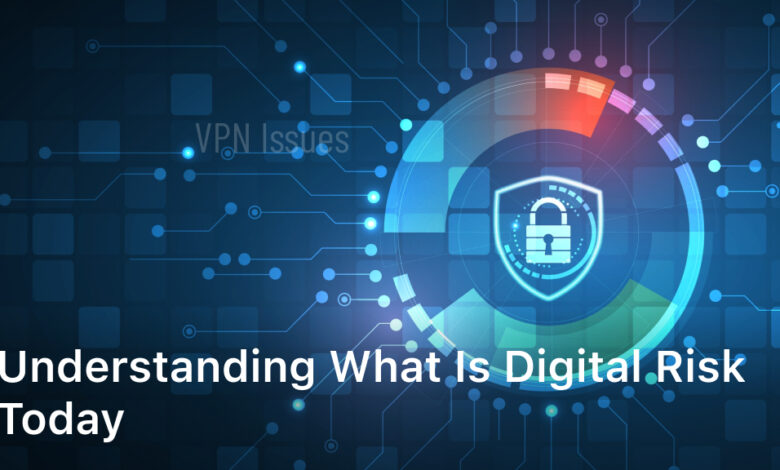
As the world becomes increasingly digital, the risks associated with managing digital assets and data are ever-present. Digital risk encompasses a wide range of potential threats, including cyberattacks, data breaches, and system failures. To protect their assets and maintain a competitive edge, organizations need effective strategies for managing digital risk. In this article, we will explore the concept of digital risk and provide insights on how organizations can protect their digital assets and data.
We will define digital risk and discuss different strategies for managing it, including conducting a digital risk assessment and analyzing digital risks using frameworks and methodologies. So, let’s dive into the world of digital risk management and explore how to safeguard your organization’s digital future.

Understanding Digital Risk
To effectively manage digital risk, it is essential to understand what it means and the various forms it can take. Digital risk refers to any potential threat to an organization’s digital assets, including sensitive data, network systems, and intellectual property.
There are numerous types of digital risk that organizations may face, including cyberattacks, data breaches, phishing scams, and social engineering attacks. With the increasing reliance on technology and digital infrastructure, the potential for digital risk has never been greater.
It is crucial for organizations to stay informed and up-to-date on the latest digital threats and vulnerabilities in today’s ever-evolving digital landscape. By understanding the different forms of digital risk and taking a proactive approach to risk management, organizations can effectively protect their digital assets and prevent potential security breaches.
Digital Risk Management Strategies
Effective digital risk management is essential for organizations looking to protect their digital assets and data. In this section, we will explore different strategies for managing digital risk, enabling organizations to identify potential threats and mitigate risks.
Key Steps in Digital Risk Management
An effective digital risk management program involves several key steps:
- Identify potential digital risks facing the organization, including cyber attacks, data breaches, and insider threats
- Evaluate the likelihood and potential impact of each risk
- Develop risk mitigation strategies, including policies and procedures to prevent and address digital risks
- Implement and continuously monitor risk management initiatives to ensure ongoing effectiveness
Practical Tips for Mitigating Digital Risks
Here are some practical tips for organizations looking to mitigate digital risks:
- Develop robust backup and recovery strategies to protect against data loss in the event of a cyber attack or data breach
- Implement strong access controls to limit unauthorized access to sensitive data and systems
- Regularly update and patch software and systems to address vulnerabilities and potential security flaws
- Provide regular cybersecurity training to employees to increase awareness of digital risks and how to prevent them
By following these strategies and implementing effective digital risk management measures, organizations can minimize the impact of digital risks and protect their assets and data from potential threats.
Conducting a Digital Risk Assessment
Organizations must conduct a digital risk assessment to stay ahead of potential threats to their digital assets and data. The assessment involves several crucial steps:
- Identifying potential threats: Organizations need to assess the range of digital risks that their operations may face. These risks could include cyber-attacks, data breaches, or malicious insider activity.
- Evaluating vulnerabilities: After identifying potential threats, organizations need to evaluate their vulnerabilities. These may include out-of-date software, open ports, weak passwords, or unsecured cloud storage.
- Quantifying potential impact: Once the potential threats and vulnerabilities have been identified, organizations need to quantify the potential impact of a breach. This helps determine the likelihood of a successful attack and how far-reaching its damage could be.
Conducting a digital risk assessment is crucial for organizations to identify and mitigate potential risks effectively. This assessment process helps businesses stay proactive, reduce their risk exposure and keep their digital assets and data safe from emerging digital threats.
Factors Contributing to Digital Risk
Digital risk is influenced by a variety of internal and external factors that can pose a significant threat to organizations. It is important to identify and assess these risk factors in order to develop effective strategies for managing digital risk.
Internal Factors
- Employee behavior and actions can contribute to digital risk. This includes things like careless password management, downloading unapproved software, and accessing sensitive data without proper authorization.
- The use of outdated hardware and software can leave an organization vulnerable to cyber attacks and other digital threats.
- Insufficient security policies and procedures can make it easier for cyber criminals to gain access to an organization’s digital assets and data.
External Factors
- The increasing sophistication of cyber attacks and malware makes it more difficult for organizations to protect their digital assets.
- The growing reliance on cloud technology and third-party vendors can create new vulnerabilities for organizations.
- The increasing connectivity of devices and systems means that a single cyber attack can have far-reaching consequences.
By understanding and addressing these and other factors, organizations can better manage digital risk and protect their valuable digital assets and data.
Analyzing Digital Risk
Effective management of digital risk requires a detailed understanding of potential threats and their potential impact on the organization. To achieve this, organizations must employ advanced digital risk analysis techniques and frameworks.
Digital Risk Analysis
Digital risk analysis is the process of evaluating potential risks to an organization’s digital assets and data. This involves identifying potential threats and vulnerabilities, assessing the likelihood and potential impact of each threat, and developing strategies to minimize risk exposure.
By conducting a thorough digital risk analysis, organizations can identify and prioritize specific areas of risk, enabling them to focus on the areas that pose the greatest threat to their operations.
Digital Risk Framework
A digital risk framework is a structured approach to understanding and managing digital risk within an organization. It provides a comprehensive set of guidelines and best practices for assessing and analyzing digital risk, as well as implementing effective mitigation strategies.
There are various digital risk frameworks available, each with its own unique approach and methodology. Some common frameworks include NIST Cybersecurity Framework, ISO 27001, and FAIR (Factor Analysis of Information Risk).
Overall, effective digital risk analysis requires a combination of advanced technical expertise and strategic thinking skills. By employing the right frameworks and methodologies, organizations can better understand and manage their digital risks, protecting their assets and ensuring business continuity in an increasingly digital world.
Conclusion
In conclusion, managing digital risk is crucial for all organizations in today’s digital landscape. By understanding the various forms of digital risk and implementing effective management strategies, businesses can protect their digital assets and data from potential threats.
Conducting a thorough digital risk assessment and analyzing digital risk using frameworks and methodologies can help organizations prioritize risk mitigation efforts and make informed decisions.
It is essential to remember that digital risks continuously evolve, and organizations need to monitor and adapt their strategies to stay ahead of emerging threats. By doing so, they can maintain a strong foundation for their digital security and protect against cyberattacks.
Overall, effective digital risk management requires ongoing efforts and investment, but the potential consequences of neglecting digital risk can be catastrophic. Therefore, businesses must prioritize and take proactive measures to protect their digital assets and data from potential threats.
FAQ
What is digital risk?
Digital risk refers to the potential harm or negative impact that can arise from the use, ownership, or adoption of various digital technologies, platforms, and channels. It encompasses risks associated with cybersecurity, data privacy, online reputation, regulatory compliance, technology failures, and more.
How can organizations manage digital risk?
Organizations can manage digital risk by implementing robust risk management strategies that involve identifying, assessing, and mitigating potential risks. This can include adopting cybersecurity measures, implementing data protection policies, conducting regular risk assessments, staying informed about emerging threats, and developing incident response plans.
Why is it important to understand digital risk?
Understanding digital risk is crucial because it helps organizations identify potential vulnerabilities, anticipate threats, and make informed decisions to protect their digital assets and data. By understanding digital risk, organizations can take proactive measures to mitigate potential risks and ensure the security and integrity of their digital operations.
What is involved in conducting a digital risk assessment?
Conducting a digital risk assessment involves identifying potential threats to an organization’s digital assets and information, evaluating vulnerabilities in its systems and processes, and quantifying the potential impact of those risks. It typically includes risk identification, risk analysis, risk evaluation, and the development of mitigation strategies.
What are some factors that contribute to digital risk?
Several factors contribute to digital risk, including internal factors such as inadequate cybersecurity measures, employee negligence, and system vulnerabilities. External factors may include cyberattacks, data breaches, evolving regulations, and emerging technologies. It is crucial for organizations to consider these factors when assessing and managing their digital risks.
How can organizations analyze digital risk?
Organizations can analyze digital risk by utilizing various frameworks and methodologies. These may include risk assessment tools, threat modeling techniques, scenario analysis, and data-driven analytics. By analyzing digital risk, organizations can gain valuable insights into their risk exposure and make informed decisions to prioritize risk mitigation efforts.





